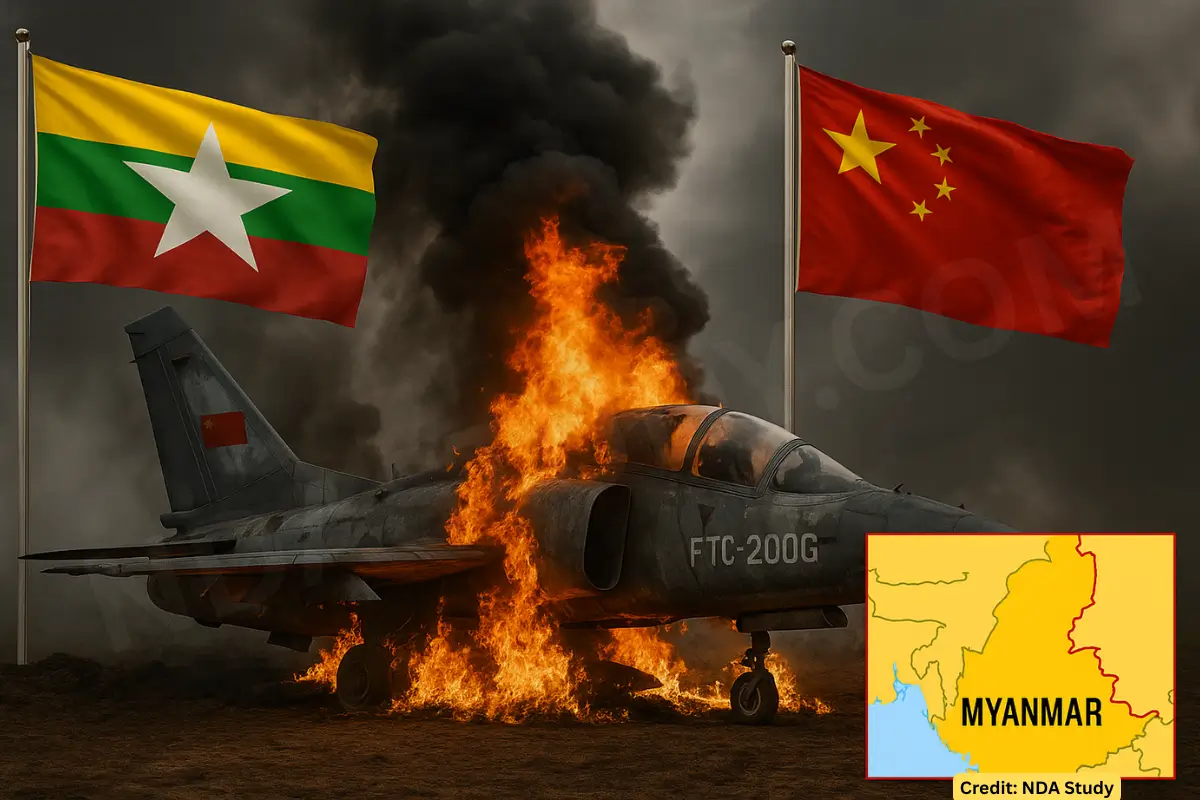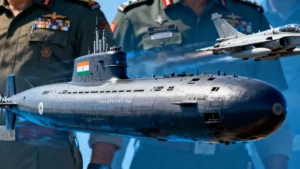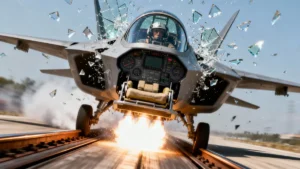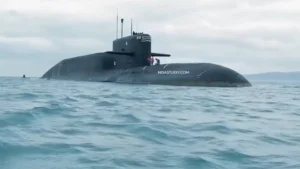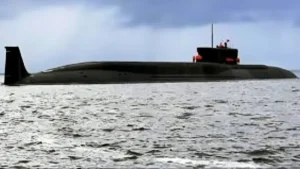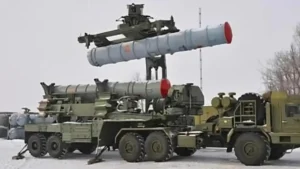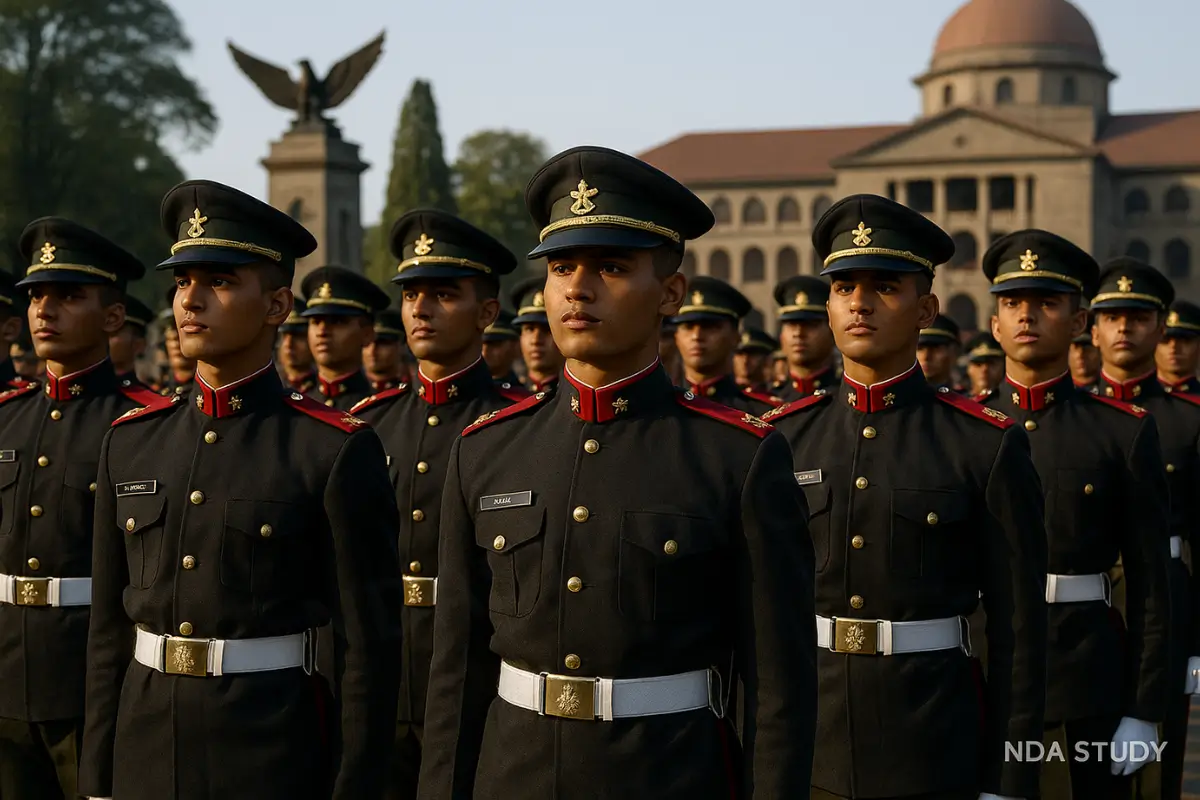On June 10, 2025, the FTC-2000G fighter shot down in Myanmar by rebel forces marked a significant shift in the battle against the Myanmar junta’s air power. Footage released by the People’s Liberation Army (PLA) highlights the implications of this incident. The loss of the $8.5 million aircraft disrupts Myanmar’s military capabilities and raises concerns about the defence relations between China and Myanmar, as well as broader regional security. This event took place near the India-Myanmar border, altering the balance of air power and posing risks to Northeast India’s security. While China’s provision of the FTC-2000G has been critical for Myanmar’s military operations, this incident reveals vulnerabilities in China’s arms exports.
For India, the FTC-2000G fighter shot down in Myanmar serves as an important lesson for its Air Force in countering asymmetric threats and adapting air warfare tactics along its northeastern border. Overall, this situation underscores the unstable nature of the conflict in Myanmar and the complex factors influencing the future of South Asia. As China’s influence continues to grow in the region, the incident with the FTC-2000G fighter jet underscores the need for a strategic reassessment of power dynamics.
FTC-2000G Fighter Shot Down in Myanmar: Incident Details
On June 10, 2025, a fighter jet from the Myanmar Air Force, made in China, was shot down near Pale Township in the Sagaing Region. This area is about 140 kilometres west of Mandalay and close to the India-Myanmar border. The jet was conducting airstrikes against rebel forces from the People’s Liberation Army (PLA) during intense fighting over the Kan Dauk police station. The PLA took responsibility for the shootdown and released videos showing the aircraft crashing into a monastery in Sabarse village. This event significantly weakens Myanmar’s air power.
| Date | Event | Why it matters |
|---|---|---|
| Nov 2022 | First six FTC‑2000G jets delivered from Guizhou via Meiktila air base. | Marks Beijing’s largest combat‑air transfer since the coup. |
| 10‑11 Jan 2023 | Camp Victoria airstrikes: Myanmar Yak‑130s bomb CNF HQ; one bomb lands in Mizoram, India. | First confirmed junta strike to breach Indian territory. |
| Apr 17 2024 | PLA Southern Theatre Command conducts live‑fire drills opposite northern Shan. | Beijing signals it will police border stability itself. |
| 16 Jan 2024 | FTC‑2000G shot down over Namhpatkar, Kachin; KIA uses FN‑6 MANPADS. | Demonstrates rebels can fell fast‑jets, not just helicopters. |
| Aug 2024 | Second batch of six FTC‑2000Gs arrives. | Junta doubles down on Chinese kit despite earlier loss. |
| Sep 5 2024 | China tightens Yunnan border security after stray shells land in Ruili. | Shows conflict’s spill‑over costs to Chinese civilians. |
| 18 Jan 2025 | Kunming ceasefire between junta & Three‑Brotherhood Alliance brokered by China. | Illustrates Beijing’s leverage as arms supplier & mediator. |
| 22 Apr 2025 | China dispatches monitoring mission to Lashio as rebels hand city back. | First PLA‑linked observer team inside Myanmar war zone. |
| 20 May 2025 | KIA downs Mi‑17 & logistics plane near Bhamo. | Further erodes junta’s rotary‑wing lift. |
| 10 Jun 2025 | FTC‑2000G shot down in Pale, Sagaing; PLA resistance group claims kill. | Confirms expanding rebel anti‑air umbrella south of Mandalay. |
Initially, state media in Myanmar claimed the jet was lost due to mechanical failure or bad weather. However, the timing of the incident and the rebels’ claims suggest that the jet was actually hit by fire from insurgents, likely using portable air defence systems. The FTC-2000G, made by Guizhou Aviation Industry Corporation in China, is a light combat aircraft that can carry up to three tons of weapons and is important to Myanmar’s military strength.
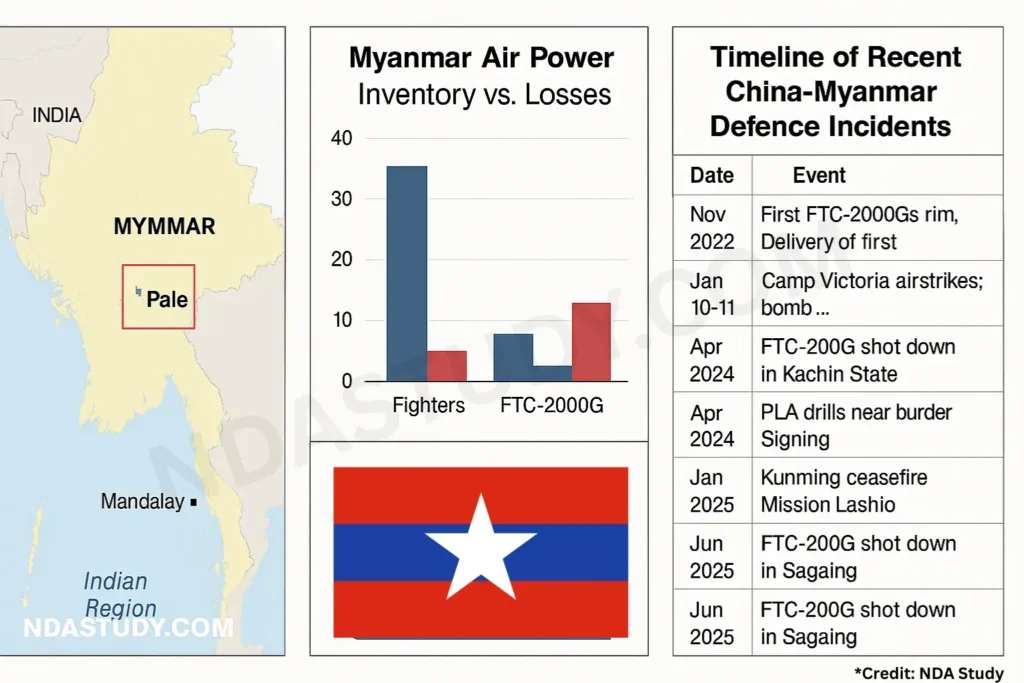
This incident shows weaknesses in Chinese fighter jets when used in asymmetric warfare, raising concerns about the reliability of China’s weapons. The shootdown near the India-Myanmar border also has serious implications for regional security and the balance of air power in Asia. It provides important lessons for the Indian Air Force as it deals with new aerial threats in its northeastern region.
China-Myanmar Defence Ties
China has significantly intensified its military support for Myanmar by supplying advanced weaponry, including FTC-2000G fighter jets and other critical platforms, to strengthen the Myanmar Air Force. Since 2024, Beijing has increased arms exports, transferred drone technology, and deployed technical experts to Myanmar’s defence industries. This reflects a strategic effort to sustain the military junta amid ongoing internal conflict.
This military aid is part of a broader geopolitical strategy aimed at securing China’s economic interests, particularly the China-Myanmar Economic Corridor (CMEC), and maintaining influence over a key neighbour that borders its Yunnan province. China’s support is driven by several motivations: safeguarding vital infrastructure projects, preserving regional stability favourable to Beijing, and countering Western influence in Southeast Asia. The establishment of joint security companies and increased cooperation between Chinese and Myanmar military forces highlight China’s commitment to protecting its investments and strategic foothold in the region.
For India, the evolving defence ties between China and Myanmar complicate the security environment along the porous India-Myanmar border. The enhanced military capabilities of Myanmar, bolstered by Chinese arms exports, present new challenges for security in Northeast India. As a result, India must recalibrate its defence preparedness, taking into account China’s growing influence in Myanmar while shaping its own strategic posture to maintain a favourable air power balance in Asia and safeguard its regional interests.
Regional Air Power Balance
The recent shootdown of a Chinese-made FTC-2000G fighter jet highlights the changing air power dynamics in Asia, especially along the India-Myanmar border. Myanmar’s air force mainly uses light combat aircraft, including the FTC-2000G and older F-7 jets. Recently, they added six Russian Su-30SME multirole fighters to improve reliability. While the FTC-2000G is cost-effective and good for close air support, it is vulnerable to portable air defence systems, as seen in ongoing conflicts.
In contrast, India’s Air Force has a more advanced and varied fleet. It includes modern Su-30MKIs, Rafales, and Tejas jets, along with strong surveillance and missile defence systems. This gives India an advantage in air combat and border security operations in the Northeast. However, the challenging terrain along the border requires constant attention and flexible strategies.
The shootdown incident provides important lessons for the Indian Air Force and defence planners. It shows the growing threat of asymmetric warfare and the need for better defences against man-portable air defence systems (MANPADS). It also emphasises the need to combine intelligence with quick-response air power. Strengthening air defence and continuing to develop homegrown technology is crucial for maintaining India’s strategic advantage as the regional situation changes.
India’s Response & Strategic Implications
The recent shootdown of the FTC-2000G fighter in Myanmar has led Indian defence officials to respond quickly. This situation raises concerns about security along the India-Myanmar border. Officials stress the need for greater vigilance and better surveillance to prevent any effects from Myanmar’s internal conflict, which is worsened by civil unrest and the military’s use of Chinese-supplied aircraft like the FTC-2000G.
In reaction, India has increased troop deployments and improved border infrastructure in the Northeast. The focus is on developing rapid response capabilities to tackle potential insurgent movements and protect territorial integrity. The shootdown has also pushed talks about modernising air defence systems and enhancing intelligence sharing to monitor cross-border threats more effectively. This situation highlights the complex defence ties between China and Myanmar and how they affect regional security.
Strategically, the incident reminds India to adjust its military stance in the Northeast. Defence planners aim to learn from the vulnerabilities seen in Myanmar’s air operations. They prioritise improving local capabilities and conducting joint exercises to maintain a strong air-power balance in Asia. This event is a key reminder of the growing aerial threats and the importance of being ready to secure India’s northeastern borders and manage insurgency challenges effectively.
Lessons for Indian Youth & Defence Aspirants
The FTC-2000G fighter shot down in Myanmar offers crucial insights for Indian youth and defence aspirants about the evolving nature of modern air warfare and regional geopolitics. This incident highlights how light combat aircraft, like the Chinese-made FTC-2000G used by the Myanmar Air Force, face significant threats from portable air defence systems in asymmetric conflict zones. It underscores the importance of integrating advanced technology with tactical adaptability in unpredictable combat environments.
For young Indians aspiring to join the defence sector, this event emphasizes the growing demand for expertise in aerospace technology, electronic warfare, and intelligence analysis. It also illustrates the strategic complexities of China-Myanmar defence ties and their impact on regional security, especially along the sensitive India-Myanmar border. Understanding these dynamics is vital for shaping India’s future military strategies and maintaining a favourable air-power balance in Asia.
This incident encourages defence aspirants to focus on research and innovation in Indigenous defence manufacturing, cyber warfare, and drone technology—fields that are increasingly critical as India seeks to modernize its forces and counter emerging aerial threats. The lessons drawn from the FTC-2000G fighter shot down in Myanmar serve as a call to action for the next generation to contribute to India’s security and technological self-reliance.
Expert Quotes & Official Statements
The FTC-2000G fighter shot down in Myanmar has drawn sharp analysis from defence experts and officials across the region. Retired Indian Air Force officer Air Marshal R.K. Sharma noted, “This incident highlights the vulnerabilities of light combat aircraft like the FTC-2000G against modern insurgent tactics using portable air defence systems. It reinforces the need for the Indian Air Force to enhance its countermeasures and surveillance along the India-Myanmar border.” Defence analyst Dr. Meera Nair added, “China’s continued arms exports, including the FTC-2000G, to Myanmar, underscore Beijing’s strategic intent to maintain influence in Southeast Asia, complicating regional security dynamics.”
From Myanmar, Ni Ni Kyaw, General Secretary of the People’s Liberation Army (PLA), claimed responsibility for downing the jet, emphasizing the growing capability of resistance forces to challenge the Myanmar Air Force’s dominance. Meanwhile, Chinese officials have remained cautious, attributing such incidents to operational risks while reaffirming their commitment to defence cooperation with Myanmar.
International observers see the shootdown as a significant event affecting the air power balance in Asia, with implications for Northeast India’s security and broader geopolitical stability. The episode offers critical lessons for the Indian Air Force in adapting to asymmetric threats and evolving aerial warfare environments.
Author’s Words: Takeaways and What’s Next
The recent incident involving the FTC-2000G fighter shot down in Myanmar serves as a significant wake-up call for India’s defence and strategic community. It reveals vulnerabilities along the India-Myanmar border and highlights the complex challenges arising from the defence ties between China and Myanmar, as well as evolving aerial threats. This event underscores the urgent need for India to strengthen its military modernisation, enhance surveillance capabilities, and adapt to asymmetric warfare in order to maintain a favourable balance of air power in Asia. For the security of Northeast India, this incident emphasises the importance of proactive measures and technological innovation.
We encourage readers to share their thoughts and engage in this critical conversation. Follow us for timely updates on this developing story and its implications for regional security and defence strategy. Your insights are invaluable as India navigates these complex challenges to safeguard its sovereignty and future.
Stay Tuned & Stay Connected!
